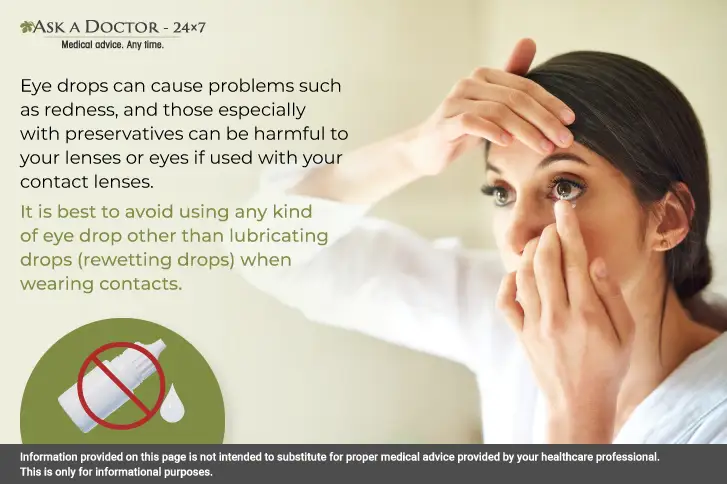Contact Lens-Related Eye Infections And How To Deal With Them
For most people, contact lenses are a more comfortable and convenient option than spectacles. However, you can't wear them constantly. Additionally, you run the risk of developing eye infections if you don't properly clean and care for them. The most common infection related to contact lens use is keratitis, an inflammation of the cornea (the transparent, dome-shaped front part of the eye). Keratitis can be caused by bacteria, fungi, viruses, and a rare parasitic infection of the eye. Additionally, wearing contacts increases your risk of developing conjunctivitis, also known as pinkeye.
It is important to practice appropriate eye care habits while wearing contact lenses to prevent infections. If you wear contact lenses, you must know how you can prevent eye infections associated with their use. Let’s discuss this in detail...
Common Symptoms of Contact Lens-Related Eye Infections

A few of the signs of infections in the eyes include:
- Unusual redness of the eye
- Itching or irritation
- Discharge of a yellow or creamy mucus, causing eyelashes to stick together
- Watery eyes
- Pain and swelling in or around the eyes
- Sudden blurry vision
- Light sensitivity (photophobia)
- Sensation that a foreign object is in your eye
What Causes Contact Lens-Induced Eye Infections?

A contact lens infection can result from a variety of factors. Among the potential sources of infection are:
- Utilizing lenses for extended wear
- Sleeping in your contact lenses
- Environmental irritants
- Having germs, fungi, or parasites grow under them
- Herpes virus
- Not cleaning your lenses or cases
- Reusing or topping off contact lens solution
Common Eye Infections & Inflammation Associated with Contact Lenses
Many contact lens-related infections occur when germs infiltrate the eye, resulting in different types of microbial keratitis, such as:
- Bacterial keratitis, a bacterial infection of the cornea. If treatment is delayed, visual loss may result.
- Viral/Herpes keratitis is a herpes virus-induced corneal illness. Mild to severe symptoms are possible.
- Acanthamoeba keratitis, a parasite-caused infection that is uncommon yet dangerous, is frequently associated with inadequate lens care.
- Fungal keratitis or fungal infection of the cornea is associated with contact lenses. Although less frequent, it can be dangerous and require specialized antifungal therapy.
- Conjunctivitis (Pink Eye) is an inflammation of the eye’s outer membrane, often caused by bacteria or viruses.
- Giant papillary conjunctivitis (GPC) is characterized by bumps behind the eyelid, often brought on by allergies or lens wear.
Other causes of inflammation due to contact lenses are:
- Contact lens-induced acute red eye (CLARE) is a common inflammatory reaction brought on by sleeping in contact lenses.
- Superficial keratitis is a surface inflammation of the cornea, possibly brought on by allergies or mechanical trauma.
Tips to Avoid Eye Infections Associated with Contact Lenses
Let’s look into the tips to help avoid eye infections associated with contact lenses:
- Take an appointment for a yearly ocular examination to maintain optimal eye health.
- Prefer using prescription contact lenses (never insert fake lenses, such as colored Halloween contacts)
- Use daily disposable contacts only once.
- Clean your contact lenses thoroughly each time you take them out. To clean your lenses, use only contact lens solution (not saline or rewetting drops).
- Never clean or store lenses with tap water.
- Put your contact lenses in the appropriate case for storage. After every usage, clean the storage case properly and let it air dry. Replace the storage case at least every three months.
- Avoid using contact lenses while you sleep.
- Pay close attention to the manufacturer's instructions and your eye doctor's advice when it comes to using, cleaning, and replacing contact lenses.
- Wash your hands with soap and warm water each time before handling your contacts
- Make sure to carry your powered vision glasses with you. In certain situations, if your contact lenses become bothersome, you can easily use your eyewear.
Whenever your eyes feel sore, red, or inflamed, or while engaging in water-related activities like swimming or taking a shower, make sure to take out your contact lenses. Also, make sure to use fresh contact solution every time you store it in the case. Do not refill or reuse old contact solution to dip the used contact lenses.
Conclusion
We all know that wearing contact lenses brings benefits like better vision and convenience, but taking good care of them is also essential. Proper eye care prevents infections and maintains eye health. Some eye infections can lead to fatal complications, including vision loss, if not treated promptly. You should get in touch with your ophthalmologist right away if you encounter signs of an eye infection. In addition to making you feel better, prompt treatment of an eye infection may save your vision. To prevent aggravating your symptoms, use glasses instead of contact lenses until your eye disease has been correctly identified.
If you have any questions related to contact lens-related eye infections, you can Ask an Ophthalmologist at Ask a Doctor - 24x7.
Recently Answered Questions Related to Eyecare and Contact Lenses
- Is It Safe To Sleep With Contact Lenses Whole Night?
- Suggest Ways To Relax Eyes After Discomfort Caused By Dryness And Itching After Wearing Contact Lenses?
- What Do Weakened Eye Blood Vessels Indicate?
- Can I Switch From RGP Contact Lenses To Astigmatism Soft Lenses While Suffering From Nystagmus?
- Can Having Keppra Lead To Vision Problem In Child?
- Suggest Ways To Relax Eyes After Discomfort Caused By Dryness And Itching After Wearing Contact Lenses?
Disclaimer: Information provided on this page is not intended to substitute for proper medical advice provided by your healthcare professional. This is only for informational purposes.
Ask a Specialist
Recent Questions


